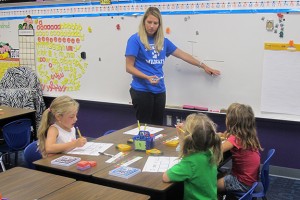Little People, Big Plans: Pre-K Preparations In Jackson County
Last week, Governor Mike Pence announced the five counties chosen to participate in the state’s first pre-k pilot program, which is scheduled for a full launch next July.

Rachel Morello / StateImpact Indiana
Students at a Jump Start program in Seymour work with their teacher on learning the alphabet.
Schools in Allen, Jackson, Lake, Marion and Vanderburgh counties plan to have the program up and running for the 2015-16 school year. That means they have exactly 12 months to prepare – and already the clock seems to be ticking rather quickly.
Of the counties selected, only Jackson is considered a rural area. With a population of more than 43,000 people, the southeastern Indiana county consists of four distinct towns, the largest of which is Seymour. Pre-k has recently become a topic of interest there, as well as in each of the outer lying towns – Brownstown, Crothersville and Medora.
“There’s a push to really see if we can move that needle up,” says Dan Hodge, executive director of the Jackson County Education Coalition. “I think everybody understands why it’s important, it’s just the logistics of getting it done.”
- What's Next For Pre-K In Jackson County?Schools in the five counties chosen to participate in Indiana’s pre-k pilot program plan to have it up and running for the 2015-16 school year. That means they have exactly 12 months to prepare and already the timer seems to be ticking rather quickly. The counties include Allen, Lake, Marion Vanderburgh and Jackson County—where StateImpact Indiana’s Rachel Morello visited a kindergarten prep class to see how education leaders there are getting ready for the pre-k program’s launch.Download
Who Will Provide Pre-K Services?
Starting in July 2015, Jackson and the four other counties will distribute vouchers to eligible families, who can use them to enroll their kids in preschools
But not just any preschool – it has to qualify as a Level 3 or 4, the top two levels on the state’s Paths to QUALITY rating system. Counties may have to work to bring existing providers up to those standards.
Currently only three providers in Jackson meet the qualifications to participate. The county houses 18 daycare home providers recognized as Level 1 providers under Paths to QUALITY, five of which have expressed interest in achieving Level 3 or 4 status.
All of the public schools have expressed interest in moving up as well.
“A lot of providers have not seen an incentive to move up in Paths to QUALITY rating,” Hodge explains. “It’s more of a commitment, more training, more time. But now, you won’t be on the roster if you’re not up to level 3 or 4.”
Since Paths to QUALITY is a voluntary program, some providers have instead opted to earn accreditation in other ways. They could still be eligible to participate in the program, if the FSSA approves their accrediting body.
One faith-based provider in Jackson is accredited by the Indiana Department of Education, and another anticipates receiving accreditation by the end of this year. Adding these two providers alone could mean serving fifty additional children.
Counties need to offer families many pre-k choices in order to meet different needs, according to Janice Read, executive director of the Child Care Network. Over the past nine years, the local non-profit and United Way agency have invested $200,000 into early childhood education programming within each of Jackson’s public school corporations.
“You just don’t want McDonald’s,” Read quips. “No, you have to have Burger King, you have to have Wendy’s, and oh, don’t forget Subway! We need to have options for our families.”
Only 48 out of 305 low-income kids in Jackson County receive services from the three eligible providers. If all goes according to plan, the families of 255 more kids will be able to choose from between 10 to 12 qualified providers next summer.
To qualify, a student’s family can earn no more than 127 percent of the federal poverty limit. That’s a little more than $28,000 a year for a family of four.
Family Matters
Finding and informing eligible kids and their parents is item number two on the counties’ to-do lists.
The Jackson County Education Coalition has already spent approximately $20,000 this year on marketing the importance of kindergarten readiness to families. The organization provides education and outreach to parents through social media, pamphlets and working with United Way agencies to identify children and families with the greatest need.
Current marketing efforts include handing out informational backpacks to kids at community events and working with the Red Cross to hand out fliers to all trailer parks in the area.
“How do you reach the folks that are not currently being served? It’s a huge piece of marketing,” Hodge says. “Just like anything with marketing, you keep beating the drum. We’re at the fair, we’ve been to the different offices, we’ve been to the shelter house. You keep showing the importance of it, not just once, not just twice, but over and over again.”
“It’s letting them know…the child needs to learn, you need help, here’s what needs to happen,” Read adds. “It’s not at all judgmental, it’s not at all negative. It’s,‘let me show you what we’ve got.’ And it works.”
Additionally, the Coalition and local providers plan to invest more time and money in a larger campaign to identify and enroll eligible children who are currently not being served.
Looking for Guidance
Also on the list: securing private donations, mapping out a parent engagement component and setting benchmarks for academic growth. Part of the pilot program also requires specific follow-up, in the form of a Kindergarten Readiness Assessment and a longitudinal study to track how the children served in 2015 will perform as 3rd graders.
But movement on some of this will have to wait, until more specific direction comes down from the state’s Family and Social Services Administration.
“The state is fine-tuning the rest of the story,” Read says. “The questions that I’ve had, most of the time the answer is, ‘we don’t know yet. We’re waiting for more information, but we’re moving forward.’ As that information is released it will help our community address that.”
Dan Hodge says he feels honored the state chose Jackson County, and doesn’t feel any any additional pressure to perform.
“With any new program, there’s a lot of details to ironed out,” Hodge says. “I’m sure there will be hiccups in the road, just as with anything else.”
“Pre-k, that’s the good beginning,” Read says. “That helps facilitate the better success at our middle schools [and] high schools, which make better the college students, that make better the employees. We want our state to succeed.”
State officials plan to see how well the pre-k program works in the initial five counties before deciding whether to expand it statewide.
Before the pilot was initiated, Indiana was one of 11 states that did not offer any publicly funded preschool.
